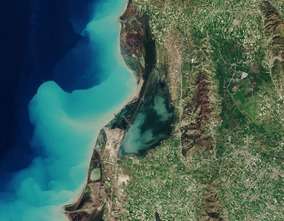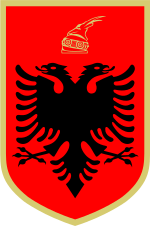Lagoon of Karavasta
Karavasta Lagoon (Albanian: Laguna e Karavastasë) is the largest lagoon in Albania and one of the largest in the Mediterranean Sea, spanning an area of 42 km2 (16 sq mi). Karavasta is part of the Divjakë Karavasta National Park and is separated from the Adriatic Sea by a large strip of sand. It sprawls across the Myzeqe coastal plain near Divjakë and some 20 km (12 mi) near Lushnjë.
| Karavasta Lagoon | |
|---|---|
IUCN category II (national park) | |
 The lagoon seen from space | |
| Location | 20 km (12 mi) from Lushnjë, Albania |
| Coordinates | 40°55′39″N 19°29′55″E |
| Length | 15.4 km (9.6 mi)[1] |
| Width | 4.1 km (2.5 mi)[1] |
| Area | 42 km2 (16 sq mi)[2] |
| Elevation | 0 m (0 ft) |
| Established | 1966[3] |
Karavasta hosts many pine trees and small sandy islands. It is renowned for hosting the Dalmatian pelican; 6.4% of the Europe's population of the Dalmatian pelican is found in Karavasta.[4][5][6] The lagoon falls within the Illyrian deciduous forests terrestrial ecoregion of the Palearctic Mediterranean forests, woodlands, and scrub. The climate is typically mediterranean.
The lagoon is located inside the boundaries of Divjaka-Karavasta National Park and has been recognised as a wetland of international importance by designation under the Ramsar Convention. The lagoon has been identified as an Important Bird Area by BirdLife International, because it supports significant numbers of the populations of various bird species.[7]
The Karavasta Lagoon is within the List of Ramsar wetlands of international importance[8] and is part of the Divjake-Karavasta National Park.
Since disinfection campaigns have long been halted, the area is known to have a very active mosquito season. However, in 2014, disinfection campaigns have started and a park rehabilitation project has been initiated by the national authorities. It included a hunting moratorium which revived bird-watching activities.
See also
| Wikimedia Commons has media related to Karavasta Lagoon. |
- Divjaka-Karavasta National Park
- Geography of Albania
- Lagoons of Albania
References
- Munari, C., Tessari, U., Rossi, R., Mistri, M. "The ecological status of Karavasta Lagoon (Albania): closing the stable door before the horse has bolted?" (PDF). Marine Environmental Research (2009). hal.archives-ouvertes.fr. p. 4. doi:10.1016/j.marenvres.2009.07.003.
The Karavasta lagoon is the largest surface (4100 ha) of this wetland complex; it is 15.4 km long and 4.1 km wide.
CS1 maint: multiple names: authors list (link) - "KARAVASTA LAGOON MANAGEMENT PLAN" (PDF). ramsar.org. p. 6.
The major feature is the large Karavasta lagoon (c.4,200 ha)
- "Bryophytes of the Karavasta Lagoon area, with new reports for Albania" (PDF). bio.bas.bg. p. 39.
The coastal lagoon, and the forested areas (Forest of Divjaka) on the northwestern side of the lagoon, have been a National Park, and therefore a protected area since 1966.
- "THE COASTAL GEOMORPHOLOGY OF THE SEMANI RIVER MOUTH-KARAVSTA LAGOON IN THE SOUTHERN ADRIATIC SEA" (PDF). balkangeophysoc.gr. p. 152.
The area well known for the Dalmatian pelican colony Pelicanus crispus which numbers some 60-70 couples, which represent 5% of the total world population of this species.
- "Bashkia Fier » Karavasta Lagoon". Bashkia Fier. Retrieved 2010-06-29.
- "ACTION PLAN FOR THE DALMATIAN PELICAN" (PDF). ec.europa.eu. p. 10.
- BirdLife International. "Karavasta Lagoon". datazone.birdlife.org.
- Ramsar (September 11, 2014). "The list of wetlands of international importance" (PDF) (in English and Spanish). Ramsar. p. 5. Retrieved 14 August 2010.
